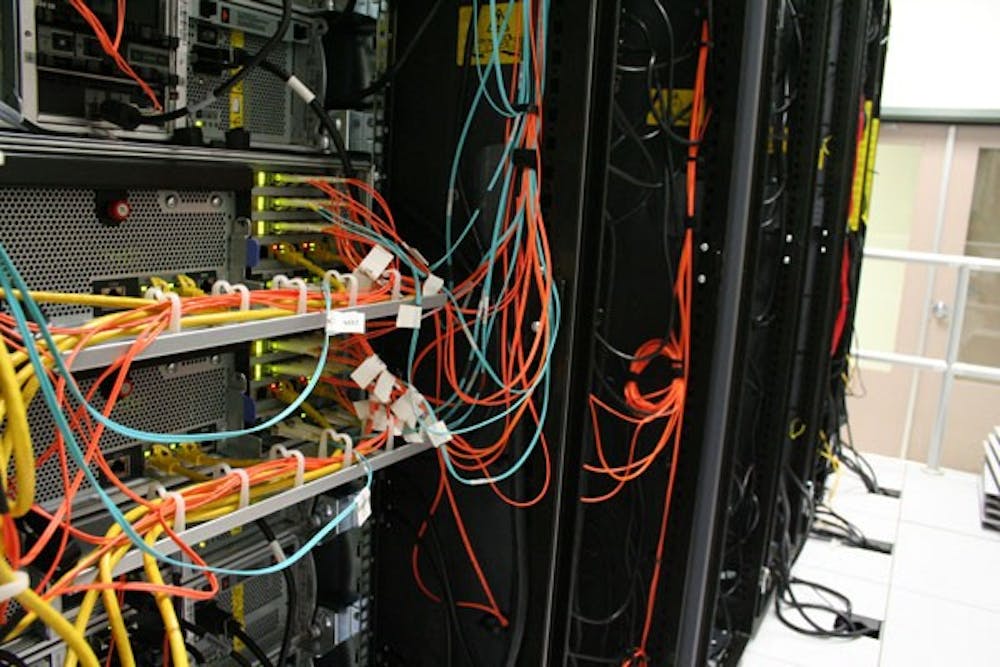In the silhouette of a wide monitor, Charles Collins points at a giant grid, moving a finger across 684 small rectangles in clusters of red and sections of greens and yellow, finally resting on two blue squares sitting side by side in the upper left corner.
“These two are being used right now to process the Lunar Reconnaissance Orbiter’s data that is being sent by satellite directly to us,” said Collins, a system administrator for “Saguaro,” ASU’s supercomputer.
NASA is relying in part on Saguaro after the program’s primary hardware failed, he said.
The display Collins is looking at is the visual representation of ASU’s supercomputer and its second-by-second status.
Saguaro’s mission is to become a top regional supercomputer center in the Southwest with an emphasis on research, said Denise Felsenthal, High Performance Center interim director.
Saguaro, along with other elements of the HPC, is housed in the Goldwater Center for Science and Engineering on ASU’s Tempe campus.
“Based on the Top 500 Supercomputer Site, we are ranked 212,” Felsenthal said.
Saguaro, which was named by the center’s previous director along with other computer systems named after native cacti, cost $2 million to build, Felsenthal said.
Collins is Saguaro’s system administrator, monitoring the supercomputer on a daily basis.
“That is why my office is right across the hall from it. They want to have someone here to yell ‘fire, fire,’” Collins joked.
Saguaro, built in 2005, is part of the High Performance Computing Initiative at ASU, a system of interconnected computer clusters working together to serve the majority of the University’s research needs, serving 858 accounts and completing more than 100,000 jobs per month.
The way Saguaro differs from a normal network of computers is through parallel computing, where a problem or task that one computer would normally solve is broken down and spread out over multiple computers, or clusters. It uses the combined resources to provide results that otherwise may be impossible to compute.
Closing the door behind him, Collins only needs a few steps to get to the large glass double doors leading to Saguaro. Inside, the room is almost deafening, as hundreds of fans are churning — trying to keep thousands of hard drives cool.
The supercomputer is spread out among a dozen or so large, towering black structures, each housing multiple computers, the fronts glowing blue and green, some flickering and others steady.
Saguaro’s inner structure is a mixture of what Collins describes as varying architectures — new and older hardware that has continued to grow and change nearly exponentially over its five-year history.
The average computer, Collins said, might have one processor and 4GB of RAM — the memory inside a computer that determines its speed.
“We have a dozen computers that use Intel’s Tigerton processors,” Collins said. “Each of these nodes (computers) has 16 processors and 64GB of RAM.”
The rest of the computers are a mixture of different amounts of processors and memory.
“Saguaro started with approximately 200 nodes and 400 processors,” Collins said. “There are now more than 700 nodes and more than 5,000 processors.”
In RAM alone, Saguaro has gone from 200GB in 2005 to its current 12 terabytes. One terabyte is 1,000 GB.
“Since 2005, Saguaro has had three major upgrades,” Collins said. “The last major upgrade was in 2008 when we doubled the size and capacity of the supercomputer.”
And it’s still looking to grow.
Application scientist Scott Menor has recently been working on securing more grants to help fund Saguaro.
The HPC is turning in a grant application within the week that would double Saguaro’s size if it was awarded to Saguaro, Menor said.
The grant would come through the National Science Foundation in the area of major researching instrumentation.
Bringing in grants helps ensure that Saguaro is maintained and improved as more and more researchers rely on its performance, Menor said, as its top users are constantly working through the supercomputer to assist their research.
“It’s all across campus,” Menor said. “[Saguaro is used by] Biodesign, TGen, School of Earth and Space Exploration, who do stellar and galaxy modeling, and engineering, doing computational fluid dynamics like modeling airflow over golf balls.”
The importance of Saguaro is immense, he said, and the ability for so much of ASU’s research rests in the resources of the supercomputer.
Collins said the people who oversee Saguaro are too few and the HPC doesn’t currently have a director.
“Our hope is that a new HPC director will quickly take the necessary steps to provide adequate staff,” Collins said.
The future for Saguaro remains one of growth, Felsenthal said.
In May, Saguaro will add another 512 processor cores to its arsenal.
Reach the reporter at kpatton4@asu.edu





